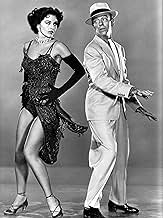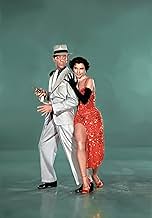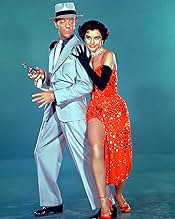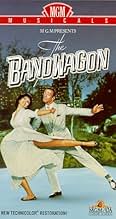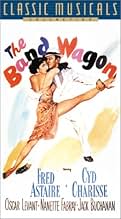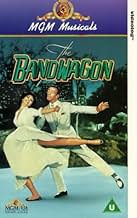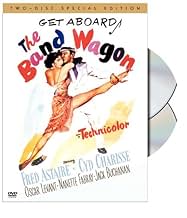VALUTAZIONE IMDb
7,4/10
13.280
LA TUA VALUTAZIONE
Un artistico e pretenzioso regista è assunto per un nuovo musical di Broadway, cambiandolo drasticamente.Un artistico e pretenzioso regista è assunto per un nuovo musical di Broadway, cambiandolo drasticamente.Un artistico e pretenzioso regista è assunto per un nuovo musical di Broadway, cambiandolo drasticamente.
- Regia
- Sceneggiatura
- Star
- Candidato a 3 Oscar
- 2 vittorie e 5 candidature totali
India Adams
- Gabrielle Gerard
- (voce (canto))
- (non citato nei titoli originali)
Fred Aldrich
- Hot Dog Vendor
- (non citato nei titoli originali)
Richard Alexander
- Stagehand
- (non citato nei titoli originali)
Ernest Anderson
- Train Porter
- (non citato nei titoli originali)
Barbara Bailey
- Dancer
- (non citato nei titoli originali)
Patsy Bangs
- Dancer
- (non citato nei titoli originali)
Lysa Baugher
- Dancer in Troupe
- (non citato nei titoli originali)
Mary Bayless
- Theatre Patron
- (non citato nei titoli originali)
Brandon Beach
- Auction Guest
- (non citato nei titoli originali)
Ralph Beaumont
- Dancer in Troupe
- (non citato nei titoli originali)
Don Beddoe
- Producer
- (non citato nei titoli originali)
Recensioni in evidenza
MGM, Arthur Freed, Vincent Minelli, Betty Comden and Adolph Green, Fred Astaire, Cyd Charisse, Oscar Levant, Nanette Fabray, Jack Buchanan and that wonderful company behind them. Wow! The Broadway musical is one of America's great contributions to the performing arts, and the Band Wagon delightfully turns its clichés on their heads, with the story of a plucky group of troopers who put all their heart and talent into...a turkey.
Great dancing includes one of Fred Astaire's classic ballet duos, "Dancing in the Dark," with Cyd Charise. She does this spin ending in a semi-kneel, with the mid-calf hem of her dress landing mid-thigh, in order to display one of those spectacular gams of hers...'tis a wonder to behold! Also, there's a number with Astaire and Jack Buchanan, one of the great British variety stars. It's a delight to see this all-too-short exhibition of contrasting dance styles by two master hoofers.
And there's the added treat of Nanette Fabray and Oscar Levant (Levant being one those, like Robert Benchley, who entertains by playing himself) standing in for Comden and Green, who happened to write The Band Wagon (as well as Singin' in the Rain and Bells are Ringing). What I like about Comden and Green is, that while most all American musicals come out of New York, the sound of Comden and Green IS New York. They once said, "New York is the ongoing background of our lives - Brooklyn girl, Bronx boy - and whether we have been conscious of it or not, it is the background..."
Yes, there's the music - five numbers, part of the great repertory of American Standards: That's Entertainment, By Myself, You and the Night and the Music, Something to Remember You By, and of course Dancing in the Dark. My favorite dance number after DITD is Shine on My Shoes, surely an under-appreciated classic. All in all, a pretty good score (no pun intended), wouldn't you say?
The story is classified as a "backstage musical," and certainly it is. But there's a scene in Band Wagon with a truly documentary feel. After the show's premier, there's a dress-down cast party. The underpaid company singers and dancers really are in it for the love, and when they want to wind down, they go somewhere cozy, get their drinks and sing a lovely, subdued song, Something To Remember You By. (Of course, after Astaire joins them, the volume goes up, and it's a miracle they aren't evicted. I guess New Haven is used to it by now.) When I was a kid I was a gofer for the Metropolitan Opera when it hit my town on its spring tours, and it's why this scene in The Band Wagon rings so true: as a fly on the wall, I saw the Met company unwinding just this way.
One more element of realism (or life imitating art imitating life): according to the trivia, Buchanan had to have triple root canal work and was in pain for most of the production, and Fabray gashed her knee in "Louisiana Hayride," then had to dance on her knees for the "Triplets" number. Ouch! Talk about plucky troopers!
This was smart and sophisticated musical comedy of the 50s, an era when New York adults still set pop trends and before American culture became corrupted and dumbed down by television. It's not just nostalgia to say they don't make them like they used to.
Great dancing includes one of Fred Astaire's classic ballet duos, "Dancing in the Dark," with Cyd Charise. She does this spin ending in a semi-kneel, with the mid-calf hem of her dress landing mid-thigh, in order to display one of those spectacular gams of hers...'tis a wonder to behold! Also, there's a number with Astaire and Jack Buchanan, one of the great British variety stars. It's a delight to see this all-too-short exhibition of contrasting dance styles by two master hoofers.
And there's the added treat of Nanette Fabray and Oscar Levant (Levant being one those, like Robert Benchley, who entertains by playing himself) standing in for Comden and Green, who happened to write The Band Wagon (as well as Singin' in the Rain and Bells are Ringing). What I like about Comden and Green is, that while most all American musicals come out of New York, the sound of Comden and Green IS New York. They once said, "New York is the ongoing background of our lives - Brooklyn girl, Bronx boy - and whether we have been conscious of it or not, it is the background..."
Yes, there's the music - five numbers, part of the great repertory of American Standards: That's Entertainment, By Myself, You and the Night and the Music, Something to Remember You By, and of course Dancing in the Dark. My favorite dance number after DITD is Shine on My Shoes, surely an under-appreciated classic. All in all, a pretty good score (no pun intended), wouldn't you say?
The story is classified as a "backstage musical," and certainly it is. But there's a scene in Band Wagon with a truly documentary feel. After the show's premier, there's a dress-down cast party. The underpaid company singers and dancers really are in it for the love, and when they want to wind down, they go somewhere cozy, get their drinks and sing a lovely, subdued song, Something To Remember You By. (Of course, after Astaire joins them, the volume goes up, and it's a miracle they aren't evicted. I guess New Haven is used to it by now.) When I was a kid I was a gofer for the Metropolitan Opera when it hit my town on its spring tours, and it's why this scene in The Band Wagon rings so true: as a fly on the wall, I saw the Met company unwinding just this way.
One more element of realism (or life imitating art imitating life): according to the trivia, Buchanan had to have triple root canal work and was in pain for most of the production, and Fabray gashed her knee in "Louisiana Hayride," then had to dance on her knees for the "Triplets" number. Ouch! Talk about plucky troopers!
This was smart and sophisticated musical comedy of the 50s, an era when New York adults still set pop trends and before American culture became corrupted and dumbed down by television. It's not just nostalgia to say they don't make them like they used to.
10latics
Just saw this again, for the first time in 10 years. What a show! This is unquestionably the last of the great line of MGM and, therefore, Hollywood musicals . . . the last real flowering of Arthur Freed's genius at holding together a team of top production talents which had produced such a fine string of musicals. Not a dull spot in the entire movie and tremendous style in Minnelli's direction. Nice to see Jack Buchanan getting a last chance in the spotlight his top hat routine with Astaire is one of the highlights of the movie. Astaire himself, playing the fading musical star which he was by 1953, has a magnificent opening with two contrasting numbers the wistful By Myself and the exuberant Shine on your Shoes tailored to set up his character perfectly. The Girl Hunt ballet is, of course, the dancing highlight of the movie and it is here that the utterly wonderful Cyd Charisse comes into her own. Apart from being arguably the best female dancer in Hollywood history, she was certainly the most beautiful: the scene in the ballet in which she appears on a bar stool and slips off her coat to reveal a dramatic red dress oozes with as much sex appeal as any movie moment I've ever seen.
There are many shimmering moments in Bandwagon: Fred Astaire (playing a role close to his own life story; he was 53 at the time), the acidic wit of Oscar Levant ('that'll keep 'em laughing!!') tempered by the sunny Nanette Fabray and musical numbers including "Shine on Your Shoes," "I Guess I'll Have To Change My Plan," and a clever novelty trio called "Triplets." But the musical sequence that stands out the most is the one which has no vocal, no dialog, and gently advances the movie's plot of whether or not oil-and-water dancers Astaire and Cyd Charisse can actually perform together (when he thinks she's too tall and she thinks he's too old). Against a Central Park twilight, the film shows its heroes enjoy a hushed walk through a park (only an instrumental refrain of 'High and Low' is heard), after which they step into an empty courtyard (he in a pastel linen suit and spectator shoes, she in a flared white dress and ballet flats; a necessity to keep her from being taller than him on film) and into the pas-de-deux of "Dancing In The Dark." It's an exquisite sequence, which at times resembles courtship, foreplay, and ultimately a romantic climax- all done in dance. It ends, just as smoothly as it began, with the two leads spinning up a short flight of stairs and mounting a hansom cab, without a single hair out of place. Now THAT's entertainment.
The Band Wagon is one of those films such as "The Maltese Falcon" and "Some Like It Hot", where just about everybody involved does the finest work of their career, both in front of and behind the camera. It is certainly the best collaboration between two legends of the musical genre, hoofer Fred Astaire and director Vincente Minnelli.
Astaire plays has-been Hollywood star Tony Hunter who hopes to revive his popularity by returning to Broadway in a new musical written by his friends Lester and Lily Marton (Oscar Levant and Nanette Fabray in essence portraying the screenplay's authors, Adolph Green and Betty Comden).
The Martons have entrusted the staging of their show to wunderkind actor/director/producer Jeffrey Cordova (a combination caricature of Orson Welles and Jose Ferrer played by British song-and-dance man Jack Buchanan). Two of Cordova's inspirations include casting ballerina Gabrielle Gerard (Charisse) as the female lead (good idea) and turning the show into a pretentious Faust allegory (really bad idea).
Tony and Gabrielle rub each other the wrong way - at first, and Cordova's joyless concoction lays an egg. But the cast vows to forge ahead and try again with another musical, this time with no mention of hell or the devil.
As clever as the script is, the main attractions are the exquisitely performed musical numbers (written by Arthur Schwartz and Howard Dietz) including "That's Entertainment", "A Shine on Your Shoes","Dancing in the Dark" and the greatest grand finale in the history of movie musicals "The Girl Hunt Ballet", a parody of film noir with Astaire as private eye Rod Riley and Charisse in a dual role as good girl and femme fatale.
Astaire plays has-been Hollywood star Tony Hunter who hopes to revive his popularity by returning to Broadway in a new musical written by his friends Lester and Lily Marton (Oscar Levant and Nanette Fabray in essence portraying the screenplay's authors, Adolph Green and Betty Comden).
The Martons have entrusted the staging of their show to wunderkind actor/director/producer Jeffrey Cordova (a combination caricature of Orson Welles and Jose Ferrer played by British song-and-dance man Jack Buchanan). Two of Cordova's inspirations include casting ballerina Gabrielle Gerard (Charisse) as the female lead (good idea) and turning the show into a pretentious Faust allegory (really bad idea).
Tony and Gabrielle rub each other the wrong way - at first, and Cordova's joyless concoction lays an egg. But the cast vows to forge ahead and try again with another musical, this time with no mention of hell or the devil.
As clever as the script is, the main attractions are the exquisitely performed musical numbers (written by Arthur Schwartz and Howard Dietz) including "That's Entertainment", "A Shine on Your Shoes","Dancing in the Dark" and the greatest grand finale in the history of movie musicals "The Girl Hunt Ballet", a parody of film noir with Astaire as private eye Rod Riley and Charisse in a dual role as good girl and femme fatale.
Director Vincente Minnelli is probably the most important star of the visually stunning film "The Bandwagon". Betty Comden and Adolph Green supplied the book and most of the songs, aided by Arthur Schwartz and Alan Jay Lerner. And the relationships, as anyone who has worked in theater can attest, are unusually understated and true. The primary story-line concerns Tony Hunter, a man who has had failures in film and has now returned to Broadway looking for a good project. His old friend portrayed by Nanette Fabray and Oscar Levant have a project in mind. But they make the mistake of hiring an ambitious director who sees in their tale a vehicle for a Faustian allegory filled with deep meanings, fire, brimstone, explosions and necrophiliac lighting. Of course the musical they produce is a total failure; and Tony has been compelled to dance with a hired ballerina, with whom he finds himself falling hopelessly in love. In desperation, he suggests they go back to the original show and not disband. As a result they craft a success, Tony gets his girl and everything ends happily. This I find to be a first-rate MGM production, using its top personnel: cinematography by Henry Jackson, art direction by Preston Ames and Cedric Gibbons, sets by Edwin Willis and Keogh Gleason, Sydney Guilaroff's hairstyles and William Tuttle's makeup, and costumes by Mary Ann Nyberg. The stars of the film are all very professional and likable. Fred Astaire is Tony, Cyd Charisse the ballerina, Nanette Fabray andOscar Levant as ilmic Comden and Green stand-ins, Jack Gardner, James Mitchell, Robert Gist, and many others in small or uncredited roles including familiar faces such as Herb Vigran, Barbara Ruick, Julie Newmar, et al. Some have complained that the musical numbers here seemed a bit static or curiously cold; but this is a musical for once where the numbers look as if they could have been musical numbers onstage; and after chasing this film for decades, when I saw it I was delighted by its stunning visual qualities; and as a theatrical veteran I was also gratified that its human relationships seemed to work, as theatrical portraits by Comden and Green and in the personages who people this very enjoyable entertainment.
Lo sapevi?
- QuizIn the DVD bonus features, Nanette Fabray stated that Oscar Levant was difficult to work with. Whenever something would go wrong or he would make a mistake, he would blame whoever was around. This included stage hands, other actors, lighting technicians, or whoever was handy. She said that, since she was usually closest, she caught the brunt of it. Following a botched take, he again blamed her for something. She lost her temper and told him off using unladylike language. Everyone on the set applauded. After that, he was much easier to work with.
- BlooperAt the New York opening night, the theater name on the marquee is Alcott Theatre, but the program cover has Stratton Theatre.
- Citazioni
Gabrielle Gerard: Oh, that's a very early Degas, isn't it?
[examines painting]
Gabrielle Gerard: 1877.
Tony Hunter: [playing up their age difference] Yeah, I swiped it from his desk in school. Was he sore.
- Versioni alternativeThere is an Italian edition of this film on DVD, distributed by DNA srl, "THE BAND WAGON (Spettacolo di varietà, 1953) - New Widescreen Edition + IL SIGNORE IN MARSINA (1943)" (2 Films on a single DVD, with "The Band Wagon" in double version 1.33:1 and 1.78:1), re-edited with the contribution of film historian Riccardo Cusin. This version is also available for streaming on some platforms.
- ConnessioniEdited into Hollywood: The Dream Factory (1972)
- Colonne sonoreBy Myself
(1937) (uncredited)
Music by Arthur Schwartz
Lyrics by Howard Dietz
Performed by Fred Astaire twice
I più visti
Accedi per valutare e creare un elenco di titoli salvati per ottenere consigli personalizzati
Dettagli
- Data di uscita
- Paese di origine
- Lingue
- Celebre anche come
- Brindis al amor
- Luoghi delle riprese
- 214 West 42nd Street, Manhattan, New York, New York, Stati Uniti(establishing shot showing the New Amsterdam Theatre)
- Azienda produttrice
- Vedi altri crediti dell’azienda su IMDbPro
Botteghino
- Budget
- 2.169.120 USD (previsto)
- Lordo in tutto il mondo
- 15.009 USD
- Tempo di esecuzione1 ora 52 minuti
- Proporzioni
- 1.33 : 1
Contribuisci a questa pagina
Suggerisci una modifica o aggiungi i contenuti mancanti




